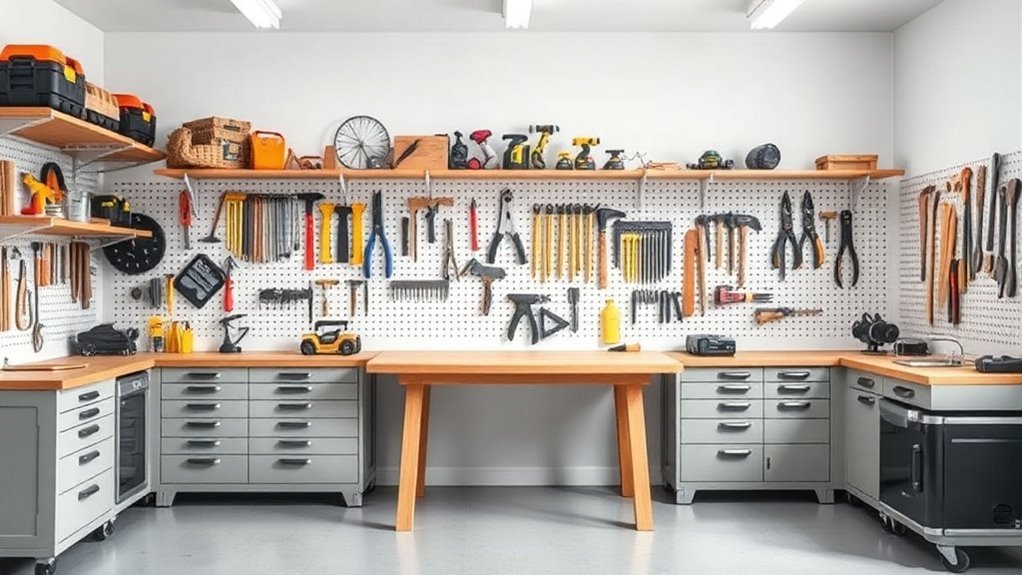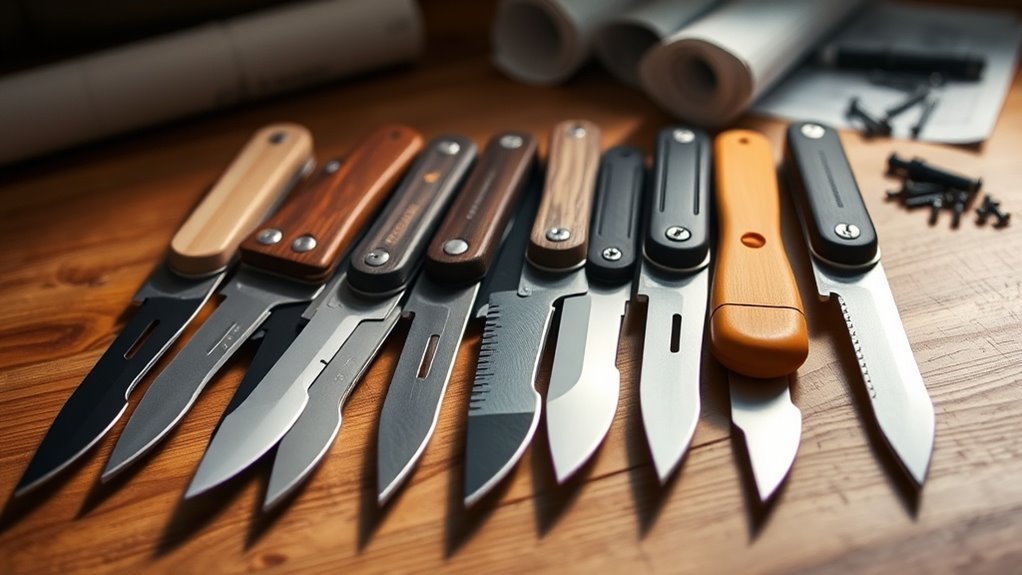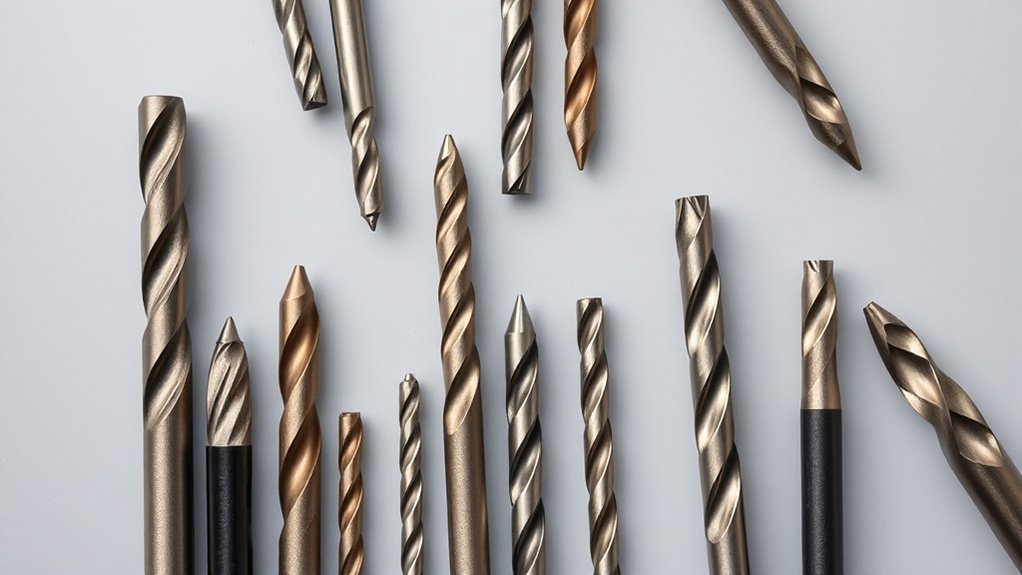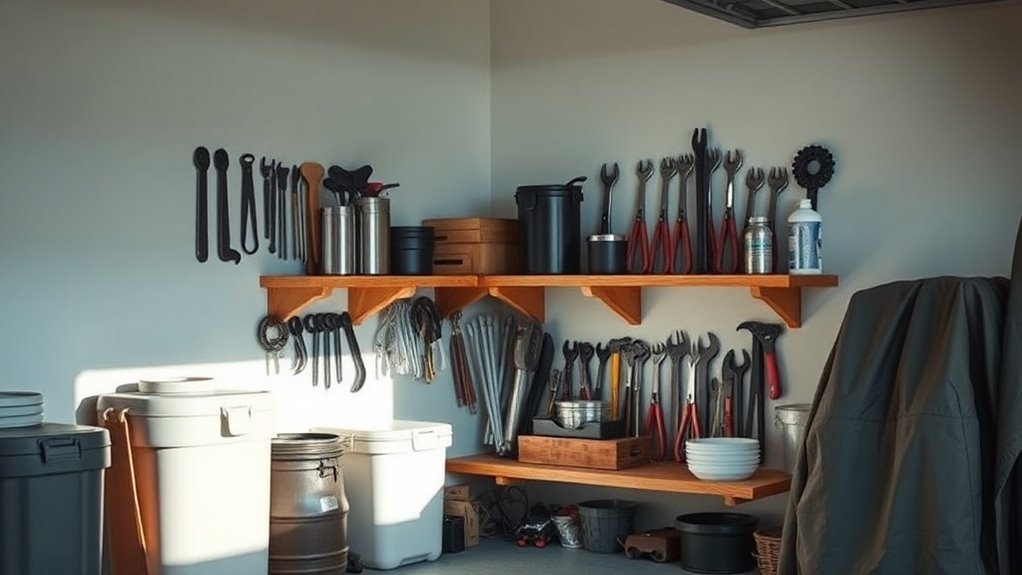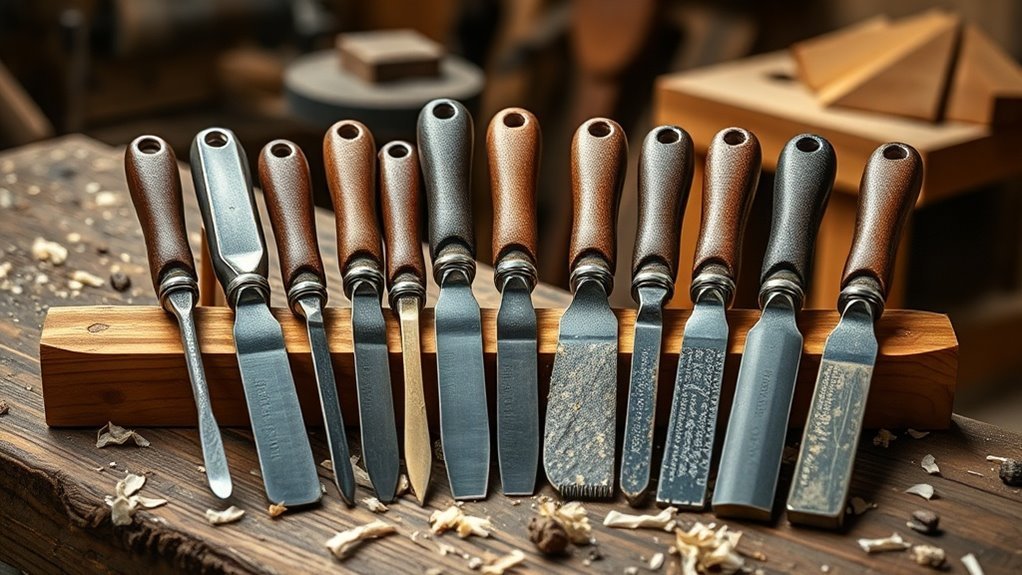How to Match the Right Blade With the Right Saw
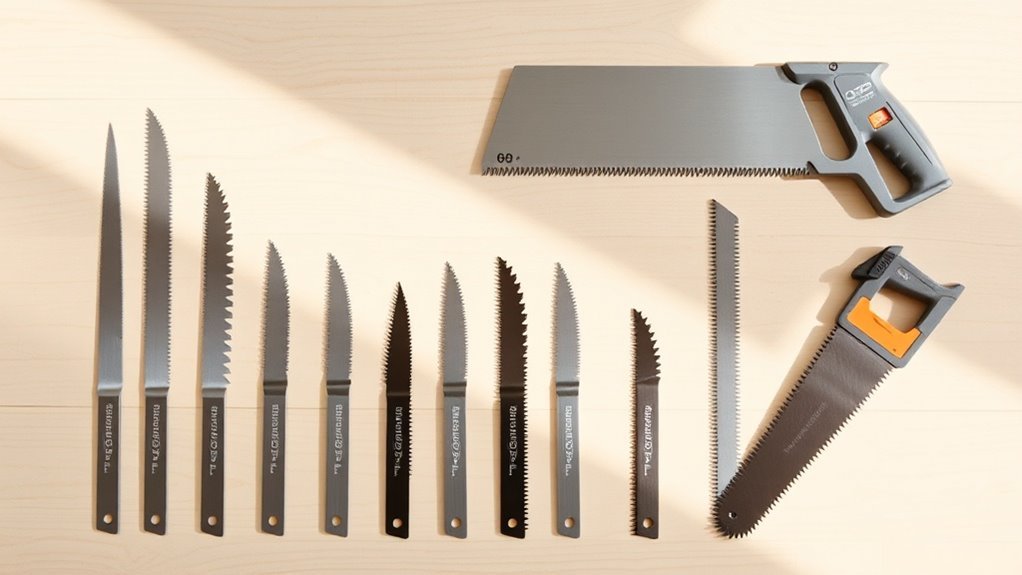
To match the right blade with your saw, consider the blade type first—whether it’s for crosscutting, ripping, or specialty tasks. Look at the material you’ll be cutting; hardwoods need different blades than softwoods. Don’t forget teeth configuration and blade diameter, as these affect cutting speed and finish quality. Always check compatibility with your saw. If you want to maximize your cutting efficiency and learn more about specific blades and maintenance, keep exploring.
Key Takeaways
- Ensure the blade diameter is compatible with the saw’s specifications for optimal performance and safety.
- Match the blade type to the material being cut, such as wood, metal, or masonry, for effective results.
- Consider the tooth configuration; higher tooth counts provide finer cuts while fewer teeth allow for faster, rough work.
- Check the saw’s operating speed and ensure the blade is rated for that speed to prevent damage and injury.
- Always verify the blade’s mounting style is compatible with the saw to ensure secure installation and performance.
Understanding Blade Types
When it comes to saw blades, understanding the different types available can make all the difference in your projects. Each blade serves a specific purpose, so knowing which one to choose is vital.
For instance, if you’re cutting wood, a crosscut blade is perfect for making smooth, clean cuts, while a rip blade excels at cutting along the grain. If metal’s on your agenda, a carbide-tipped blade works wonders for durability and precision.
For specialty materials, you might want a diamond blade, especially for tile or masonry.
Material Considerations
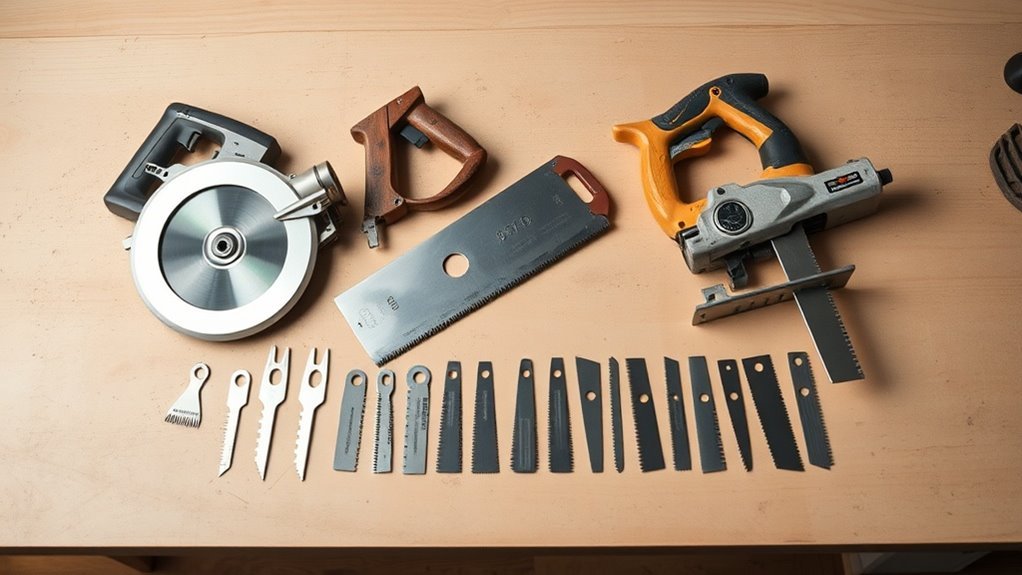
Selecting the right blade also means considering the materials you’ll be cutting. Different materials demand different blade specifications.
For instance, if you’re working with hardwood, you’ll need a blade that can handle dense fibers without dulling quickly. Conversely, softwoods require blades designed for quicker cutting.
When it comes to metals, use blades with specialized teeth, like carbide-tipped ones, to prevent wear and guarantee smooth cuts.
For cutting composites or plastics, a blade with fewer teeth will help minimize melting and deliver cleaner edges. Always keep in mind the material’s thickness; thicker materials typically need a sturdier blade.
Teeth Configuration
When choosing the right blade, the teeth configuration plays an essential role in your cutting performance.
You’ll want to contemplate both the tooth count and shape to match your specific project needs.
Understanding these factors can help you achieve cleaner cuts and better efficiency.
Tooth Count Importance
Understanding tooth count is essential for optimizing your saw’s performance, as it directly affects the cutting efficiency and finish quality.
Generally, a higher tooth count means finer, smoother cuts, making it ideal for materials like hardwood or plywood. Conversely, blades with fewer teeth cut faster, which is beneficial for rough cuts or softwoods.
It’s vital to match the tooth count to your project needs; too many teeth can lead to overheating, while too few may cause rough edges. Always consider the material’s composition and thickness when selecting the blade.
By doing so, you’ll achieve the desired results and prolong your saw and blade’s lifespan.
Tooth Shape Variations
While tooth count is important, the shape and configuration of those teeth also play a significant role in cutting performance. Different tooth shapes, like flat-topped, round-tipped, or alternate bevel, are designed for specific tasks.
For instance, flat-topped teeth are great for creating smooth finishes on hardwood, while round-tipped teeth are better suited for making fast cuts in softer materials. The spacing between teeth also impacts the cut; wider gaps allow for faster material removal but can leave a rough finish.
When selecting a blade, consider the material you’re cutting and the finish you desire. Understanding these tooth shape variations will help you make a more informed choice and improve your overall cutting efficiency.
Blade Diameter
Choosing the right blade diameter is essential because it directly affects your cutting efficiency and accuracy. A larger diameter blade typically allows for deeper cuts and smoother finishes, making it ideal for thicker materials.
However, it may not be suitable for detailed work, where smaller blades excel. If you’re cutting intricate patterns or curves, a smaller blade diameter gives you more control and precision.
For intricate patterns or curves, smaller blade diameters provide enhanced control and precision, perfect for detailed cutting work.
When selecting a blade, consider the type of material you’ll be cutting and the thickness you’ll encounter. Additionally, guarantee your saw can accommodate the chosen blade diameter, as incompatibility can lead to safety issues or poor performance. The choice of blade material—such as high-speed steel—can also influence cutting efficiency and durability.
Ultimately, matching the right blade diameter to your specific cutting needs will enhance both your results and overall experience.
Cutting Speed and Feed Rate
Getting the cutting speed and feed rate right is essential for achieving ideal results. Both influence the quality of your cut and the lifespan of your blade.
Cutting speed refers to how fast the blade moves through the material, while feed rate is how quickly you’re feeding the material into the blade. If the cutting speed’s too slow, you might burn the material; if it’s too fast, you could dull your blade or warp the material.
Similarly, an improper feed rate can lead to jamming or excessive wear. You’ll want to consult the manufacturer’s guidelines for best settings specific to your material and project.
Tooth Geometry
When picking the right saw blade, tooth geometry plays a vital role in performance.
Different tooth shapes can impact your cutting speed and the quality of the finish.
It’s important to understand these variations to choose the best blade for your project. Additionally, the selection of materials used in the blade, such as high-carbon steel, can significantly influence durability and cutting efficiency.
Tooth Shape Variations
Understanding tooth shape variations is essential for optimizing your sawing experience, as the geometry of the teeth directly influences cutting effectiveness. Different tooth shapes serve distinct purposes. For instance, flat teeth provide a clean cut and are ideal for hardwood, while curved teeth excel at cutting softer materials.
Additionally, the angle of the tooth can determine the depth of cut; sharper angles offer faster cuts but may reduce control. You’ll want to take into account the type of material you’re tackling and the desired finish.
Finally, tooth spacing affects chip removal and performance; wider spacing helps in clearing debris, while closer spacing improves smoothness. Selecting the right tooth shape variation tailored to your project guarantees you’ll achieve the best results.
Cutting Speed Considerations
Selecting the right tooth geometry can considerably affect cutting speed during your sawing tasks.
Teeth with larger hooks allow for faster cuts in soft materials, as they create a more aggressive cutting action. However, if you’re working with harder materials, opt for a tooth design with smaller hooks, which can provide smoother cut lines and reduce binding.
Also, pay attention to tooth count; a blade with more teeth generally offers a finer finish but may cut slower. Conversely, fewer teeth can speed up the cutting process at the expense of finish quality.
Specialty Blades for Unique Applications
While most saw blades are designed for general cutting tasks, specialty blades are tailored for unique applications that demand specific characteristics. These blades can enhance your cutting efficiency and provide the results you need.
Here’s a quick overview of some common specialty blades:
| Blade Type | Purpose | Features |
|---|---|---|
| Dado Blade | Wide grooves in wood | Multiple blades for width |
| Melamine Blade | Clean cuts on laminate | Fine teeth for smoothness |
| Abrasive Blade | Cutting hard materials | Durability for tough jobs |
| Scroll Blade | Intricate shapes | Narrow and flexible |
| Diamond Blade | Masonry and tile | Long-lasting precision |
Choosing the right specialty blade can make all the difference in your projects, so always assess your specific needs before making a selection!
Maintenance and Care for Saw Blades
If you want your saw blades to perform at their best and last longer, proper maintenance and care are crucial. Start by regularly cleaning the blades to remove any resin or debris buildup. A simple solution of soap and water works well, but make certain to dry them thoroughly afterward to prevent rust.
Inspect your blades for chips or dullness and sharpen or replace them as needed to guarantee peak cutting performance. In addition, store your blades in a dry, protected area to avoid any damage.
Finally, always check the alignment and tension when installing the blades to prevent unnecessary wear and tear. Additionally, staying consistent with regular maintenance will enhance the longevity and effectiveness of your blades. By following these steps, you’ll keep your blades sharp, efficient, and ready for your next project.
Common Mistakes to Avoid
What pitfalls should you steer clear of when choosing a blade for your saw?
First, don’t ignore the material compatibility; using the wrong blade can lead to poor cuts or even damage your saw.
Next, avoid choosing a blade simply based on its appearance. Just because it looks good doesn’t mean it’s the right fit.
Also, be wary of using a blade that’s too fine for your project, as it can bind and break easily.
Finally, don’t forget to check the tooth count; too many teeth can slow you down, while too few can result in rough cuts.
Questions
Can I Use Any Blade on My Saw Model?
You can’t use just any blade on your saw model. Each saw type requires specific blades designed for their functions. Check your saw’s manual to verify you’re using the compatible blade for peak performance.
How Often Should I Replace Saw Blades?
When it comes to saw blades, it’s better to be safe than sorry. You should replace them every few months or after about 20 hours of use, depending on the material and frequency of your projects.
What Brands Are Recommended for Quality Blades?
For quality blades, consider brands like DeWalt, Bosch, Makita, and Freud. They’re known for durability and performance, so you’ll get the precision you need for your projects. Don’t skimp on blades; they’re essential tools.
Are There Safety Tips for Using Saw Blades?
Absolutely, always wear safety goggles and gloves, right? Guarantee your workspace is clear and stable. Keep hands away from the blade, and never force the saw. Familiarize yourself with the tool before use for maximum safety.
Can I Sharpen Saw Blades at Home?
Yes, you can sharpen saw blades at home. Just make certain you have the right tools, like a file or a sharpening kit, and follow the manufacturer’s guidelines to guarantee safety and effectiveness.
Conclusion
Choosing the right blade for your saw is like pairing the perfect wine with dinner; the right match enhances your project and makes the whole experience smoother. By understanding blade types, materials, and configurations, you’ll avoid common pitfalls and guarantee your cuts are precise and efficient. So, take the time to select wisely, and you’ll find your saw will perform like a finely tuned instrument, producing results that hit all the right notes.

